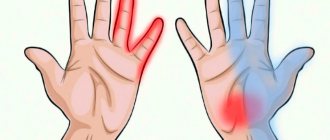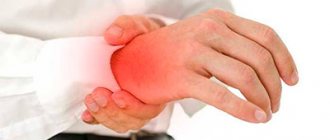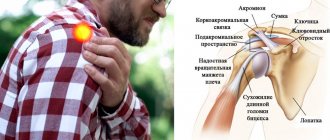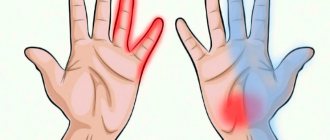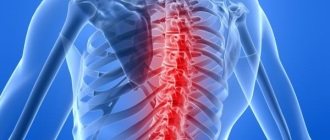The reasons for numbness in the right hand are quite different. In many ways, the appearance of unpleasant sensations is explained by the formation of pathology of the spine, nerves or blood vessels. This symptomatology does not always pose a danger to the life/health of the body. Short-term numbness (for example, at night) often depends on an uncomfortable position taken during sleep. Frequent hand numbness for no apparent reason requires a medical examination to determine the exact causes of the disease. In this case, treatment (massage, medications, other physiotherapy procedures) is prescribed by the doctor himself.
Short-term numbness at night is associated with poor quality sleep or wearing tight clothing, which compresses blood vessels and provokes poor circulation in general.
Why does my hand go numb?
Physiological reasons
Short-term numbness immediately after waking up is provoked by compression of blood vessels and nerves due to the awkward position of the hand. Accompanied by tingling, “goosebumps”, “disobedience” of the limb. It occurs in people who put their arm under their body or under a pillow, or throw a limb behind their head. Disappears a few minutes after changing body position.
Neuropathies
Numbness of the hand is determined by neuritis of infectious etiology, neuropathies due to compression of the nerve trunks by bone growths, tumors, inflammatory infiltrates:
- Radial nerve.
Hypoesthesia is detected along the back of the shoulder and the dorsum of the forearm. - Ulnar nerve.
There is a loss of sensitivity on the ulnar side of the palm. - Median nerve.
The radial half of the palm suffers.
Polyneuropathy
Characterized by symmetrical damage to the arms. Initially, the process involves mainly the distal parts of the limb, then numbness, paresthesia, and other symptoms spread in the proximal direction. Polyneuropathies occur with alcoholism, severe somatic diseases, oncological processes, some infections, vibration disease, exogenous intoxications. Sometimes they develop during pregnancy.
Plexit
Damage to the upper bundle of the brachial nerve plexus is manifested by numbness of the outer side of the forearm and shoulder, the lower bundle - hypoesthesia of the inner side of the shoulder, forearm, and hand. Combined with weakness of the muscles of the same localization. With total involvement of the brachial plexus, a decrease or loss of sensitivity is detected on both the outer and inner sides of the arm. The causes of brachial plexitis are:
- Birth injuries
with the formation of obstetric paralysis. - Traumatic injuries
: shoulder dislocation, clavicle fracture, damage to the ligamentous apparatus of the shoulder joint. - Compression of the brachial plexus
: aneurysm, hematoma, cervical rib, neoplasm. - Infectious diseases
: herpes, cytomegaly, brucellosis, tuberculosis, syphilis. - Dysmetabolic disorders
: diabetes mellitus, gout, dysproteinemia, metabolic diseases. - Iatrogenic damage
during operations and manipulations.
Numb hand
Scalenus syndrome
Scalenus syndrome occurs as a result of compression of the branches of the brachial plexus, subclavian arteries and veins by the scalene muscles. A characteristic feature of the pathology is the sudden onset of symptoms. Pain in the neck, arm, and head is accompanied by muscle weakness, paresthesia, pale skin of the arm, weakening or absence of pulse. The area of numbness is determined by the involvement of certain branches of the plexus.
The most common cause of scalene syndrome is cervical osteochondrosis. Muscle compression also develops with curvature of the spine, after injuries, against the background of congenital anomalies, weightlifting, and significant weight gain.
Radicular syndrome
Numbness of the hand develops due to compression, traumatic injury, or inflammation of the spinal roots at the level of the lower cervical and upper thoracic vertebrae. The causes are osteochondrosis, intervertebral hernia, spondylosis. The symptom can be detected with injuries of the spinal column, spondylolisthesis, vertebral osteomyelitis, spinal meningitis. Sometimes radicular syndrome is formed against the background of neuromas of the roots, tumors of the spinal cord. The topic depends on the affected root:
- C5 – numbness on the outside of the shoulder;
- C6 – sensitivity of the outer surface of the forearm is impaired;
- C7 – the back surface of the shoulder and forearm suffers;
- C8 – hypoesthesia is detected along the inner surface of the forearm;
- T1-T2 – numbness of the hand is possible.
Myelopathy
Dystrophic changes in the spinal cord are accompanied by sensory disturbances below the level of damage. The extent of changes depends on the extent of the lesion. Hypoesthesia or loss of sensitivity in the hands is caused by myelopathies of the following origin:
- Spondylogenic and discogenic:
osteochondrosis, spondylosis, spondyloarthrosis, involutive spondylolisthesis, disc protrusion, intervertebral hernia - Ischemic:
transient cerebrospinal circulatory disorders, spinal stroke. - Post-traumatic
: concussion, spinal cord contusion, fractures with spinal cord damage, other spinal cord injuries. - Carcinomatous
: paraneoplastic processes in lymphogranulomatosis, leukemia, lung cancer, and other oncological processes. - Infectious
: neuroAIDS, neurosyphilis, Lyme disease. - Other
: toxic, radiation (against the background of radiation therapy), metabolic (for endocrine diseases, metabolic disorders).
Other nervous diseases
Numbness and tingling are the most common auras associated with migraines. They start at the fingertips and spread to the entire arm and half of the neck. Then the disturbances disappear and are replaced by headaches. Numbness, tingling, burning with senestopathies are distinguished by a significant variety of localization, combination with other, often fanciful complaints. Migrating sensations, periodic or constant, can spread to various areas of the body, including the hands.
Vascular damage
Takayasu's disease is manifested by numbness, weakness, and pain in the arms, resulting from inflammatory damage to the aorta and large arteries. Depending on the location of the inflammation, one or both limbs may be affected. An external examination reveals weakening or absence of pulsation and paleness of the hands. Fainting, dizziness, visual disturbances, and heart problems are possible.
Unlike other obliterating vascular diseases, thromboangiitis obliterans can affect the vessels of not only the lower but also the upper extremities. Pain, numbness in the hands and forearms, pallor, cyanotic distal parts of the extremities, absence of pulse, formation of painful nodules on the fingers, and trophic disorders are noted.
Other reasons
A list of other diseases that may be accompanied by numbness in the hands includes:
- ODS diseases
: bursitis of the shoulder joint, glenohumeral periarthrosis. - Cardiovascular pathologies
: ischemic heart disease, myocardial infarction. - Mental disorders
: panic disorder, hysteria.
What preventive manipulations can reduce pain?
Numbness of the right hand is much easier to prevent than to treat already in the process. Preventive manipulations include a certain list of procedures, as well as strict control over nutrition. It is important not to worry about trifles and adhere to the right lifestyle. Experts recommend improving the level of blood circulation in the closet section of the spine and preventing further development of acute pathologies and other deformations that may affect the preservation of motor activity.
You can supplement the basic set of activities with certain exercises. So, you need to sit on a chair, grab your shoulders with your hands and begin to perform circular movements with your joints 10 times in one direction and 10 times in the other. After this, you can cross your fingers and place them on the back of your head, keeping your elbows at the same level. After this, you need to bring them together and spread them apart about 15 times each. All exercises are performed slowly and completely relaxed to eliminate the risk of additional joint injury. Some of the preventive manipulations should be done while standing, straightening your back and cervical spine to create the correct body position.
Diagnostics
The etiology of hand numbness is determined by a neurologist. In case of vascular pathology, consultation with a vascular surgeon is required. The specialist examines the history of the disease, assesses the condition of the limb, pulse in the arteries, identifies swelling, signs of inflammation, and other changes. A neurological examination includes the study of sensitivity, reflexes, and muscle strength. Based on the results, the following are assigned:
- Electrophysiological studies
. ENG, EMG, evoked potentials are carried out to differentiate damage to nerves, muscles and structures of the central nervous system, to clarify the location and degree of damage to the nerve trunk. - Radiography
. Performed for injuries, suspected compression of nerves by bone growths, neoplasms. Visualizes fractures, dislocations, osteophytes, bone deformities. - Vascular studies
. Informative for scalene muscle syndrome, Takayasu's disease, thromboangiitis obliterans. To determine the localization and severity of occlusion, vascular ultrasound, angiography, and aortography can be performed. - Other visualization techniques
. Computed tomography and magnetic resonance imaging are performed for diseases and traumatic injuries. Prescribed in case of ambiguous results of basic studies and planning of surgical interventions. - Lab tests
. Recommended for confirming the infectious and dysmetabolic genesis of polyneuropathies and diagnosing Takayasu’s disease.
Acupuncture
In what cases is it necessary to seek help from specialists?
It is necessary to immediately consult a doctor in cases where the following symptoms are associated with numbness of the hand:
- coordination of movements becomes difficult;
- pain occurs;
- weakness, shortness of breath, and dizziness occur;
- disturbances in speech function are observed;
- sensitivity to temperature decreases.
The occurrence of the above pathologies in combination with numbness of the hand may indicate the presence of a serious pathology that threatens health and life. Therefore, when they appear, you must immediately contact a doctor who will conduct an examination, make a diagnosis and prescribe the necessary treatment.
Treatment
Pre-hospital assistance
In case of numbness due to neurological diseases, it is necessary to exclude loads that provoke an increase in symptoms, and take regular breaks to rest the hands. In case of traumatic injuries, the injured segment of the limb should be fixed or the victim with a spinal injury should be placed on a backboard and given an anesthetic. Increasing swelling, intense pain, followed by numbness of the limb, are reasons for immediate contact with a specialist.
Conservative therapy
The treatment regimen for neurological causes of hand numbness includes the following areas:
- Pain relief
. Drugs from the NSAID group are used; in case of severe pain, a blockade is performed with an anesthetic or a mixture of an anesthetic and a corticosteroid drug. - Normalization of muscle tone
. Tolperisone, methyllycaconitine hydroiodide, and baclofen are effective in reducing muscle tone and eliminating spasms. - Improving blood circulation
. To improve blood supply and stimulate venous outflow, pentoxifylline, aminophylline, and troxerutin are recommended.
Patients are prescribed B vitamins and diuretics to eliminate edema. According to indications, the treatment plan is supplemented with chondroprotectors. Chronic pain may require antidepressants. The list of non-drug methods includes ultraphonophoresis, UHF, hydrotherapy, therapeutic mud, ozokerite and paraffin applications. An important role is given to massage, exercise therapy, manual therapy, and reflexology.
For Takayasu's disease, immunosuppressants, antiplatelet agents, and anticoagulants are recommended. Plasma cascade filtration, lymphocytapheresis, and plasmapheresis are performed. For thromboangiitis, antispasmodics, NSAIDs, and agents to improve the rheological properties of blood and activate local metabolism are used. They give a referral for ILBI, hyperbaric oxygenation, hemosorption.
Surgery
The tactics of surgical intervention are determined by the nature of the pathology that provoked numbness of the hands. Neuralgia due to nerve compression by a tumor, scars, fibrous or bone growths are considered as an indication for neurolysis, tumor removal or decompression intervention.
For spinal pathologies, discectomy, scoliosis correction, and operations to eliminate spinal stenosis and instability of the spinal column are used. The cause of brachial plexitis is eliminated by removing cervical ribs, excision of tumors and aneurysms, and correcting the position of fragments in fractures.



